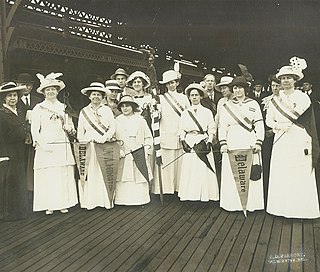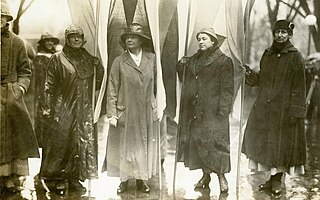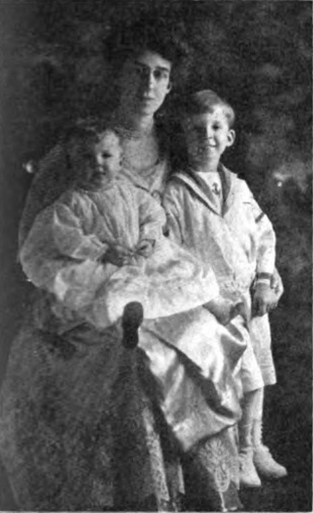
Women's suffrage was established in the United States on a full or partial basis by various towns, counties, states and territories during the latter decades of the 19th century and early part of the 20th century. As women received the right to vote in some places, they began running for public office and gaining positions as school board members, county clerks, state legislators, judges, and, in the case of Jeannette Rankin, as a member of Congress.

Julian Kennedy was an American engineer and inventor, known for his national and international contributions to the steel industry. He was awarded the ASME Medal in 1928.
Jennie Bradley Roessing was a leader in Pennsylvania's women's suffrage movement during the early 1900s. She was an active participant in the women's suffrage movement and various Pittsburgh-area organizations.

Women's suffrage in Alabama went through several stages. Early women's suffrage work in Alabama started in the 1860s. Priscilla Holmes Drake was the driving force behind suffrage work until the 1890s. Several suffrage groups were formed, including a state suffrage group, the Alabama Woman Suffrage Organization (AWSO). The Alabama Constitution had a convention in 1901 and suffragists spoke and lobbied for women's rights provisions. However, the final constitution continued to exclude women. Women's suffrage efforts were mainly dormant until the 1910s when new suffrage groups were formed. Suffragists in Alabama worked to get a state amendment ratified and when this failed, got behind the push for a federal amendment. Alabama did not ratify the Nineteenth Amendment until 1953. For many years, both white women and African American women were disenfranchised by poll taxes. Black women had other barriers to voting including literacy tests and intimidation. Black women would not be able to fully access their right to vote until the passage of the Voting Rights Act of 1965.

Women's suffrage in Delaware began in the late 1860s, with efforts from suffragist, Mary Ann Sorden Stuart, and an 1869 women's rights convention held in Wilmington, Delaware. Stuart, along with prominent national suffragists lobbied the Delaware General Assembly to amend the state constitution in favor of women's suffrage. Several suffrage groups were formed early on, but the Delaware Equal Suffrage Association (DESA) formed in 1896, would become one of the major state suffrage clubs. Suffragists held conventions, continued to lobby the government and grow their movement. In 1913, a chapter of the Congressional Union (CU), which would later be known at the National Women's Party (NWP), was set up by Mabel Vernon in Delaware. NWP advocated more militant tactics to agitate for women's suffrage. These included picketing and setting watchfires. The Silent Sentinels protested in Washington, D.C., and were arrested for "blocking traffic." Sixteen women from Delaware, including Annie Arniel and Florence Bayard Hilles, were among those who were arrested. During World War I, both African-American and white suffragists in Delaware aided the war effort. During the ratification process for the Nineteenth Amendment, Delaware was in the position to become the final state needed to complete ratification. A huge effort went into persuading the General Assembly to support the amendment. Suffragists and anti-suffragists alike campaigned in Dover, Delaware for their cause. However, Delaware did not ratify the Nineteenth Amendment until March 6, 1923, well after it was already part of the United States Constitution.

This is a timeline of women's suffrage in Delaware. Suffragists in Delaware began to fight for women's suffrage in the late 1860s. Mary Ann Sorden Stuart and national suffragists lobbied the Delaware General Assembly for women's suffrage. In 1896, the Delaware Equal Suffrage Association (DESA) was formed. Annual state suffrage conventions were held. There were also numerous attempts to pass an equal suffrage amendment to the Delaware State Constitution, but none were successful. In 1913, a state chapter of the Congressional Union (CU) was opened by Mabel Vernon. Delaware suffragists are involved in more militant tactics, including taking part of the Silent Sentinels. On March 22, 1920, Delaware had a special session of the General Assembly to consider ratification of the Nineteenth Amendment. It was not ratified by Delaware until 1923.

Women's suffrage in Nevada began in the late 1860s. Lecturer and suffragist, Laura de Force Gordon, started giving women's suffrage speeches in the state starting in 1867. In 1869, Assemblyman Curtis J. Hillyer introduced a women's suffrage resolution in the Nevada Legislature. He also spoke out on women's rights. Hillyer's resolution passed, but like all proposed amendments to the state constitution, must pass one more time and then go out to a voter referendum. In 1870, Nevada held its first women's suffrage convention in Battle Mountain Station. In the late 1880s, women gained the right to run for school offices and the next year several women are elected to office. A few suffrage associations were formed in the mid 1890s, with a state group operating a few women's suffrage conventions. However, after 1899, most suffrage work slowed down or stopped altogether. In 1911, the Nevada Equal Franchise Society (NEFS) was formed. Attorney Felice Cohn wrote a women's suffrage resolution that was accepted and passed the Nevada Legislature. The resolution passed again in 1913 and will go out to the voters on November 3, 1914. Suffragists in the state organized heavily for the 1914 vote. Anne Henrietta Martin brought in suffragists and trade unionists from other states to help campaign. Martin and Mabel Vernon traveled around the state in a rented Ford Model T, covering thousands of miles. Suffragists in Nevada visited mining towns and even went down into mines to talk to voters. On November 3, the voters of Nevada voted overwhelmingly for women's suffrage. Even though Nevada women won the vote, they did not stop campaigning for women's suffrage. Nevada suffragists aided other states' campaigns and worked towards securing a federal suffrage amendment. On February 7, 1920, Nevada became the 28th state to ratify the Nineteenth Amendment.
This is a timeline of women's suffrage in Florida. Ella C. Chamberlain began women's suffrage efforts in Florida starting in 1892. However, after Chamberlain leaves the state in 1897, suffrage work largely ceases until the next century. More women's suffrage groups are organized, with the first in the twentieth century being the Equal Franchise League in Jacksonville, Florida in 1912. Additional groups are created around Florida, including a Men's Equal Suffrage League of Florida. Suffragists lobby the Florida Legislature for equal suffrage, hold conventions, and educate voters. Several cities in Florida pass laws allowing women to vote in municipal elections, with Fellsmere being the first in 1915. Zena Dreier becomes the first woman to legally cast a vote in the South on June 19, 1915. On May 26, 1919, women in Orlando vote for the first time. After the passage of the Nineteenth Amendment, Helen Hunt West becomes the first woman in Florida to register to vote under equal franchise rules on September 7, 1920. Florida does not ratify the Nineteenth Amendment until May 13, 1969.

This is a timeline of women's suffrage in Maine. Suffragists began campaigning in Maine in the mid 1850s. A lecture series was started by Ann F. Jarvis Greely and other women in Ellsworth, Maine in 1857. The first women's suffrage petition to the Maine Legislature was sent that same year. Women continue to fight for equal suffrage throughout the 1860s and 1870s. The Maine Woman Suffrage Association (MWSA) is established in 1873 and the next year, the first Woman's Christian Temperance Union (WCTU) chapter was started. In 1887, the Maine Legislature votes on a women's suffrage amendment to the state constitution, but it does not receive the necessary two-thirds vote. Additional attempts to pass women's suffrage legislation receives similar treatment throughout the rest of the century. In the twentieth century, suffragists continue to organize and meet. Several suffrage groups form, including the Maine chapter of the College Equal Suffrage League in 1914 and the Men's Equal Suffrage League of Maine in 1914. In 1917, a voter referendum on women's suffrage is scheduled for September 10, but fails at the polls. On November 5, 1919 Maine ratifies the Nineteenth Amendment. On September 13, 1920, most women in Maine are able to vote. Native Americans in Maine are barred from voting for many years. In 1924, Native Americans became American citizens. In 1954, a voter referendum for Native American voting rights passes. The next year, Lucy Nicolar Poolaw (Penobscot), is the Native American living on an Indian reservation to cast a vote.

Hannah Jane Patterson was an American suffragist and social activist. She was a key member of the women's suffrage movement in Pennsylvania and worked for the National American Woman Suffrage Association. During World War I Patterson was a member of the Woman's Committee of the Council of National Defense. For her service, she was awarded with a Distinguished Service Medal. Patterson graduated from Wilson College and studied at both Columbia University and the University of Pennsylvania.

Women's suffrage in Pennsylvania was an outgrowth of the abolitionist movement in the state. Early women's suffrage advocates in Pennsylvania not only wanted equal suffrage for white women, but for all African Americans. The first women's rights convention in the state was organized by Quakers and held in Chester County in 1852. Philadelphia would host the fifth National Women's Rights Convention in 1854. Later years saw suffragists forming a statewide group, the Pennsylvania Woman Suffrage Association (PWSA), and other smaller groups throughout the state. Early efforts moved slowly, but steadily, with suffragists raising awareness and winning endorsements from labor unions.

Women's suffrage in North Dakota began when North Dakota was still part of the Dakota Territory. During this time activists worked for women's suffrage, and in 1879, women gained the right to vote at school meetings. This was formalized in 1883 when the legislature passed a law where women would use separate ballots for their votes on school-related issues. When North Dakota was writing its state constitution, efforts were made to include equal suffrage for women, but women were only able to retain their right to vote for school issues. An abortive effort to provide equal suffrage happened in 1893, when the state legislature passed equal suffrage for women. However, the bill was "lost," never signed and eventually expunged from the record. Suffragists continued to hold conventions, raise awareness, and form organizations. The arrival of Sylvia Pankhurst in February 1912 stimulated the creation of more groups, including the statewide Votes for Women League. In 1914, there was a voter referendum on women's suffrage, but it did not pass. In 1917, limited suffrage bills for municipal and presidential suffrage were signed into law. On December 1, 1919, North Dakota became the twentieth state to ratify the Nineteenth Amendment.

This is a timeline of women's suffrage in North Dakota. Women's suffrage in North Dakota began while it was still part of the Dakota Territory. In 1879, women in the territory gained the right to vote in school meetings. Later, this was more formalized in 1883, providing women separate ballots for school issues. After North Dakota was a state, suffragists continued to work for full suffrage. A referendum on equal suffrage took place in 1914, but failed. In 1917, women gained the right to vote in municipal and presidential elections. On December 1, 1919, North Dakota became the 20th state to ratify the Nineteenth Amendment.

Women's suffrage in South Dakota started when it was part of Dakota Territory. Prior to 1889, it had a shared women's suffrage history with North Dakota. While South Dakota was part of the territory, women earned the right to vote on school related issues. They retained this right after it became a separate state. The state constitution specified that there would be a women's suffrage amendment referendum in 1890. Despite a large campaign that included Susan B. Anthony and a state suffrage group, the South Dakota Equal Suffrage Association (SDESA), the referendum failed. The state legislature passed additional suffrage referendums over the years, but each was voted down until 1918. South Dakota was an early ratifier of the Nineteenth Amendment, which was approved during a special midnight legislative session on December 4, 1919.

This is a timeline of women's suffrage in South Dakota. The early history of women's suffrage in the state is shared with North Dakota. When South Dakota became a state, it held a voter referendum in 1890 on an equal suffrage amendment. This effort failed, but suffragists continued to organize and lobby the legislature to pass voter referendums. None passed until 1918. South Dakota ratified the Nineteenth Amendment on December 4, 1919.

This is a timeline of women's suffrage in New Jersey. Women and African Americans had the right to vote in New Jersey until the state constitution was changed in 1807, disenfranchising all but white men. Any early suffrage protest was taken by Lucy Stone in 1857 who refused to pay her property taxes because she could not vote. Additional attempts to make women more equal under the law took place in the 1880s and 1890s. There were also several court cases that challenged women's right to vote in the state. Eventually, a voter referendum on a state constitutional suffrage amendment took place in 1915, however the measure was voted down. Activists continued to fight both in the state and to protest in Washington, D.C. as Silent Sentinels. By February 10, 1920, New Jersey ratified the Nineteenth Amendment.

Lucy Kennedy Miller (1880–1962), also known as Mrs. John O. Miller, was a prominent 20th-century American suffragist who became the president of the Equal Franchise Federation of Pittsburgh, Pennsylvania and the first president of the Pennsylvania League of Women Voters (PLWV). In 1919, the League of Women Citizens of Pennsylvania called her "the woman to whom, more than to any other" was "owe[d] the triumph of" women's suffrage in the Commonwealth of Pennsylvania.

Eliza Kennedy Smith, also known as Mrs. R. Templeton Smith, was a 20th-century American suffragist, civic activist, and government reformer in Pittsburgh, Pennsylvania. Upon her death in 1964, The Pittsburgh Press described her as "a relentless, tenacious watchdog of the City's purse strings" who "probably attended more budget sessions over the years than anyone else in Pittsburgh either in or out of government".

This is a timeline of women's suffrage in Iowa. Women's suffrage work started early in Iowa's history. Organizing began in the late 1960s with the first state suffrage convention taking place in 1870. In the 1890s, women gained the right to vote on municipal bonds, tax efforts and school-related issues. By 1916, a state suffrage amendment went to out to a voter referendum, which failed. Iowa was the tenth state to ratify the Nineteenth Amendment in 1919.






















